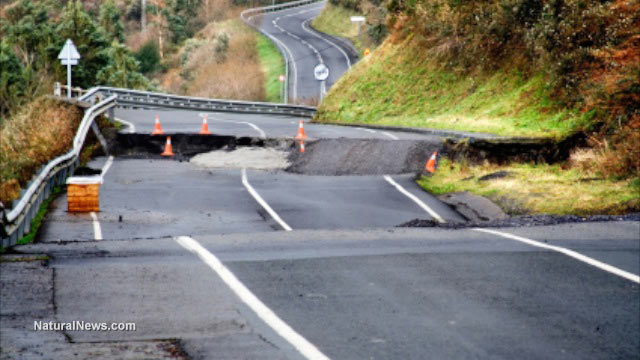Major earthquake now due for middle America... would unleash mass chaos and kill thousands
Tuesday, June 28, 2016 by: J. D. Heyes
Tags: earthquakes, Middle America, disaster

(NaturalNews) In November 2012 thousands of National Guard soldiers and personnel from disaster preparedness agencies from Missouri and other states conducted "Operation Vigilant Guard," a large training exercise aimed at responding to a major earthquake along the New Madrid fault line.
According to a press release from the Missouri National Guard public affairs office, "under the exercise scenario, citizen-soldiers and airmen will have to contend?with a number of issues including disrupted public utilities and widespread?infrastructure damage."
Since then smaller exercises have taken place and additional planning and resources lined up. It's all for a very good reason.
As reported by Britain's Express newspaper recently, though many seismologists and geologists remain focused on underground activity in California's San Andreas fault, others are beginning to pay more attention to New Madrid.
Four of the largest quakes in recorded history
The 150-mile long New Madrid Seismic Zone near Missouri's boot heel is becoming a major concern as many believe it is way overdue for a major tremor that is likely to affect seven states – Missouri, Illinois, Tennessee, Arkansas, Kentucky, Indiana and Mississippi. The seismic zone has not seen significant quakes or tremors for more than 200 years.The Express reported further:
In the winter of 1811 and 1812 there were three earthquakes of magnitude 7 - as high as 7.7 - and a series of aftershocks across the American Midwest.
The results were catastrophic, with the course of the Mississippi being diverted, chasms ripping open, and volcanoes of sand and water bursting through the ground.
The Federal Emergency Management Agency (FEMA) warned in 1999 there were four natural disasters which threatened the states.
They included major hurricanes hitting Miami and New Orleans, which has recently been rocked by Katrina, and megaquakes hitting Los Angeles, and the central USA.
The zone has had four of the largest earthquakes in recorded history, with all of them occurring within a three-month period between December 1811 and February 1812; Missouri did not become a state until April 1821.
The U.S. Geological Survey, or USGS, has a map of the country with a large pink warning area over the heart of the Midwest. Each year there are hundreds of small tremors within the New Madrid zone, including a 3.5 magnitude quake in May, which many experts saw as a warning sign of bigger quakes to come. Following that activity, the USGS even raised the threat level for New Madrid for 2016, Express reported.
Though the risk of a major tremor in New Madrid is not as well-publicized as the risk of quakes and tremors in California and along the West Coast, transportation officials recently spent $260 million to upgrade and strengthen the I-40 bridge that spans the Mississippi into Memphis, Tenn. Officials now hope that the span – which towers over the river – is strong enough to withstand the anticipated major quakes.
'The thing that makes the river scary is all the industry we have along it'
In addition, officials in Memphis reduced the main hospital by nine floors to limit the risk of a collapse from a major tremor, at an additional cost of $64 million.In 2009 the Mid-America Earthquake Center at the University of Illinois released a report suggesting that a quake of a magnitude of 7.0 or greater was possible within the New Madrid Seismic Zone.
Amr Elnashai, the study's lead author, wrote, "All hell will break loose." Many experts have said tens of thousands of Americans could die; predictions included the loss of 715,000 buildings – including 130 hospitals – and 3,500 bridges, which would cripple transportation for years.
The report estimated as many as 86,000 deaths with a combined loss of $300 billion in damages.
James Wilkinson, the director of the Central U.S. Earthquake Consortium, which is located next to the Memphis international airport, said he is concerned that a major quake could release the Mississippi from a series of levees designed to prevent flooding, which would only add to the damage.
"The thing that, to me, makes the river scary is how much industry we have along it: there's power plants, there's chemical plants, there's ports," he told The Atlantic. "And the river might change course altogether."
Sources:
http://www.pulaskicountydaily.com
http://www.express.co.uk
http://www.theatlantic.com
Earthquakes at FETCH.news
Get independent news alerts on natural cures, food lab tests, cannabis medicine, science, robotics, drones, privacy and more.
Take Action: Support Natural News by linking to this article from your website
Permalink to this article:
Embed article link: (copy HTML code below):
Reprinting this article:
Non-commercial use OK, cite NaturalNews.com with clickable link.
Follow Natural News on Facebook, Twitter, Google Plus, and Pinterest
- Newly released JFK files reveal Pentagon's role in creating Lyme disease and covid in the same lab
- Dr. Suzanne Humphries makes bombshell appearance on Joe Rogan podcast, exposing vaccine industry deception back to POLIOMYELITIS
- L.A.'s rebuilding nightmare: Only 4 permits issued after fire destroys 6,000 homes
- Discovery of vast underground city beneath Giza pyramids challenges human history
- Black cumin seed oil emerges as a powerful ally against breast cancer and chronic inflammation
- Catastrophic 7.7 earthquake devastates Myanmar and Thailand; death toll could reach 100,000
- AI breakthrough slashes celiac disease diagnosis time from months to minutes
- The hidden battle in your glass: How A1 and A2 milk could shape your health
- Sugar-free deception: Artificial sweeteners hijack hunger signals, fuel obesity epidemic, study warns
- Europe braces for WAR as EU urges citizens to STOCKPILE FOOD, in latest provocations with Russia
- Thomas Massie’s Dual Loyalty Disclosure Act aims to restore American sovereignty by cracking down on foreign influence in Congress
- Putin vows to 'finish off' Ukraine, accuses West of prolonging the war
- Aluminum pollution: A silent threat to human health
- Tesla owners under siege: Road rage, vandalism and political backlash fuel fear among drivers nationwide
- Kiss Your Genetic Privacy Good-Bye! 23andMe Gets Green Light to Sell Your Intimate Genetic Details to Anyone They Want
- Chaos in Amsterdam: Five injured in broad daylight knife attack near Dam Square
- "Feel G.O.O.D. Gut Health Program" on BrightU: Dr. Basima Williams introduces the Feel-Good Plate Method
- Trump's 25% auto tariffs: A bold move to strengthen U.S. manufacturing despite short-term challenges
- Newly released JFK files reveal Pentagon's role in creating Lyme disease and covid in the same lab
- Analysis: The coming economic collapse, a mass uprising and Trump's three secret weapons to halt the growing revolt
- Trump nominates VACCINE ZEALOT Susan Monarez to lead the CDC, sidelining RFK Jr.'s reform efforts
- Trump's greatest betrayal so far: Accelerating Middle East wars, silencing dissent, and serving Zionist masters
- Dr. Mike Yeadon releases 15-minute testimony - WATCH - about genocidal intent of COVID “vaccines”
- Festive flavors: The sweet history, nutritional profile and health benefits of pecan pie
- Elon Musk: Aliens could be here on Earth RIGHT NOW
- Big Pharma's $8 Billion bribery scheme exposed: how doctors are pushed to prescribe junk science, not heal
- 5 Simple steps to boost your brainpower: How to strengthen executive function in a distracted world
- Trump reverses course on Gaza plan, says “nobody is expelling Palestinians”
- A lack of integrity in Academia: Harvard professor found GUILTY of fraudulent research to promote CRT theory
- Reclaim your health: How midlife exercise reverses years of inactivity
- Survival 101: Effective EMF blocking techniques
- Florida takes a stand: DeSantis proposes permanent ban on mRNA vaccine mandates
- Sugarcane extract superior to cholesterol-lowering drugs?
- California's social media censorship law struck down: A victory for free speech or a threat to online safety?
- OpenAI whistleblower who dissented against how the company trained ChatGPT found dead
- EPA advisor admits the agency is funneling billions to climate groups ahead of Trump’s return to White House
- EPA advisor admits the agency is funneling billions to climate groups ahead of Trump’s return to White House
- Newly released JFK files reveal Pentagon's role in creating Lyme disease and covid in the same lab
- California's social media censorship law struck down: A victory for free speech or a threat to online safety?
- Dr. Mike Yeadon releases 15-minute testimony - WATCH - about genocidal intent of COVID “vaccines”
- The Health Ranger releases “Vaccine Zombie” song and music video, using AI-animated zombies for the music video
- The pandemic as a tool for INDOCTRINATION: Understanding “The Indoctrinated Brain” by Dr. Michael Nehls
- Florida takes a stand: DeSantis proposes permanent ban on mRNA vaccine mandates
- “Why we influenced the 2020 elections”: Facebook files reveal the coordinated effort to bury the Hunter Biden laptop story
- Mike Adams releases country western hit single: Goin’ Back in Time is Comin’ Home
- Mike Adams releases music poetry sensation: A Child of God
- Unpacking the Lies That We’ve Been Fed – new song and music video released by Mike Adams, the Health Ranger
- Michigan sheriff announces criminal investigation into 2020 election crimes, Dominion Voting Systems
- Migrants are taking advantage of recent hurricanes to scam residents and loot their homes
- House Intelligence Committee calls for the ARREST and PROSECUTION of Dr. Anthony Fauci
- RFK Jr. clears key hurdle: Sen. Susan Collins backs controversial HHS nominee, signaling a new era for health policy
- Rep. Nancy Mace introduces bill to ban biological males from female facilities on federal property
- Peter Rost exposes Big Pharma corruption in his book “The Whistleblower: Confessions of a Healthcare Hitman”
- Mike Adams releases new song and music video: Nothing More Disgusting Than a Globalist
- Red Cross issues warning to stop blood plasma donations from vaccinated people
- Scientists confirm: GENIUS brain function can be spontaneously unleashed in humans without any apparent cause
- EPA advisor admits the agency is funneling billions to climate groups ahead of Trump’s return to White House
- HYSSOP: What research reveals about the health benefits of this ancient holy herb
- Two containers with completed ballots fall out of truck in Florida
- Fully vaccinated about to see “tsunami” of illness and death, warns virologist
- Global leaders unite to clamp down on “misinformation” with UN-backed Cascais Declaration
- BREAKING: 2025 NDAA authorizes mandatory military draft of WOMEN across America… as Pentagon pursues global NUCLEAR war with both Russia and China at the same time
- Michael Yon warns of a ZIONIST TAKEOVER in Trump’s second administration
- BOMBSHELL: DNA testing kits are a SCAM to develop ethnic-specific bioweapons
- Ozempic and Wegovy weight loss drugs are injectable LIZARD VENOM PEPTIDES that may unleash a devastating wave of organ failure… side effects align with symptoms of SNAKE BITES
- Israeli soldiers accused of even more torture and abuse in the West Bank
- These 13 countries just signed an agreement to engineer a global FAMINE by destroying food supply
- NASA admits that climate change occurs because of changes in Earth’s solar orbit, and NOT because of SUVs and fossil fuels
- RFK Jr. clears key hurdle: Sen. Susan Collins backs controversial HHS nominee, signaling a new era for health policy
- Sermon 30: How Jesus reveals Caesar’s FAKE CURRENCY and FALSE AUTHORITY
- Coriander seeds: Ancient medicine backed by modern science
- Arizona officials claim Maricopa County needs 10-13 days to tabulate results of the election
Science News & Studies
Medicine News and Information
Food News & Studies
Health News & Studies
Herbs News & Information
Pollution News & Studies
Cancer News & Studies
Climate News & Studies
Survival News & Information
Gear News & Information
News covering technology, stocks, hackers, and more



"Big Tech and mainstream media are constantly trying to silence the independent voices that dare to bring you the truth about toxic food ingredients, dangerous medications and the failed, fraudulent science of the profit-driven medical establishment.
Email is one of the best ways to make sure you stay informed, without the censorship of the tech giants (Google, Apple, Facebook, Twitter, YouTube, etc.). Stay informed and you'll even likely learn information that may help save your own life."
–The Health Ranger, Mike Adams












































